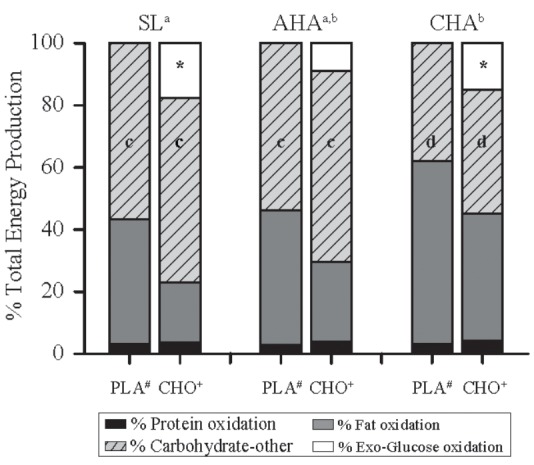FIGURE 4.

The percentage contribution from oxidation of different energy substrates to total energy production during the last 40 min of 80-min steady-state exercise (treadmill walking) in participants provided 1.8 g/min carbohydrate (CHO, n = 8, 65.25 g fructose + 79.75 g glucose) or non-nutritive placebo (PLA, n = 6) at sea level (SL) and at 4,300 m altitude, within 5–7 h after arrival (acute high-altitude, AHA) and again on the 22nd day of continuous residence at high-altitude (chronic high-altitude, CHA). For PLA, “other” carbohydrate oxidation is entirely endogenous carbohydrate (i.e., glucose provided by muscle and liver glycogen) oxidation, but for CHO, “other” carbohydrate is endogenous carbohydrate oxidation and exogenous fructose oxidation, the latter of which was not captured by the tracer techniques employed in the CHO group. a,bContribution from oxidation of fat was greater and from carbohydrate (exogenous glucose + other) less at CHA than at SL, but neither differed from AHA (main effect of phase, P < 0.05). ∗In CHO, contribution of exogenous carbohydrate oxidation was less at AHA than at SL or CHA, which did not differ (main effect of phase, P < 0.05). c,dContribution from oxidation other carbohydrates at SL and AHA did not differ, but was greater than at CHA. #Contribution of fat oxidation greater in PLA than CHO during all trials (main effect of treatment, P < 0.05). +Contribution of carbohydrate (exogenous glucose + other carbohydrate) oxidation was greater in CHO than PLA during all trials (main effect of treatment, P < 0.05).
